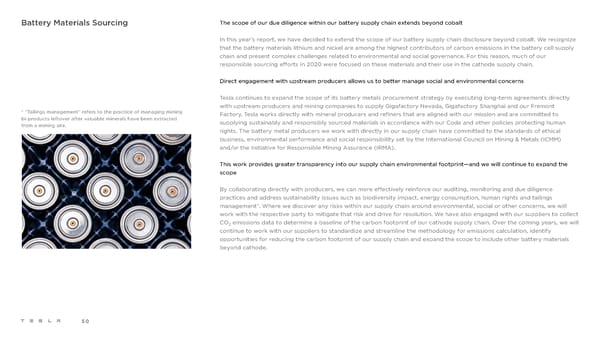Battery Materials Sourcing The scope of our due diligence within our battery supply chain extends beyond cobalt In this year’s report, we have decided to extend the scope of our battery supply chain disclosure beyond cobalt. We recognize that the battery materials lithium and nickel are among the highest contributors of carbon emissions in the battery cell supply chain and present complex challenges related to environmental and social governance. For this reason, much of our responsible sourcing efforts in 2020 were focused on these materials and their use in the cathode supply chain. Direct engagement with upstream producers allows us to better manage social and environmental concerns Tesla continues to expand the scope of its battery metals procurement strategy by executing long-term agreements directly with upstream producers and mining companies to supply Gigafactory Nevada, Gigafactory Shanghai and our Fremont * “Tailings management” refers to the practice of managing mining Factory. Tesla works directly with mineral producers and refiners that are aligned with our mission and are committed to bi-products leftover after valuable minerals have been extracted supplying sustainably and responsibly sourced materials in accordance with our Code and other policies protecting human from a mining site. rights. The battery metal producers we work with directly in our supply chain have committed to the standards of ethical business, environmental performance and social responsibility set by the International Council on Mining & Metals (ICMM) and/or the Initiative for Responsible Mining Assurance (IRMA). This work provides greater transparency into our supply chain environmental footprint—and we will continue to expand the scope By collaborating directly with producers, we can more effectively reinforce our auditing, monitoring and due diligence practices and address sustainability issues such as biodiversity impact, energy consumption, human rights and tailings management*.Where we discover any risks within our supply chain around environmental, social or other concerns, we will work with the respective party to mitigate that risk and drive for resolution. We have also engaged with our suppliers to collect CO2emissions data to determine a baseline of the carbon footprint of our cathode supply chain. Over the coming years, we will continue to work with our suppliers to standardize and streamline the methodology for emissions calculation, identify opportunities for reducing the carbon footprint of our supply chain and expand the scope to include other battery materials beyond cathode. 50
 Tesla Impact Report 2020 Page 49 Page 51
Tesla Impact Report 2020 Page 49 Page 51